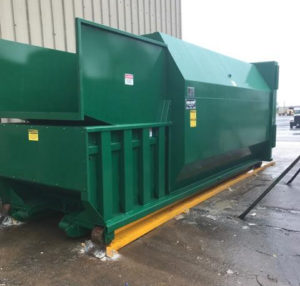So you are in charge of a facility that generates large amounts of waste? The garbage man is at your facility so often you might make him sign a lease agreement. Your trash cans are consistently overfilled, and when you see your trash bill, you start googling, “How to sell my firstborn?”
You should consider a trash compactor.

Here are three key considerations you should review before placing a trash compactor.
- What size compactor do you need? The best way to figure this out is to look at your existing trash bills and determine how many cubic yards of trash you are having hauled per week. Let’s say you have a 4-yard container, pulled 6 days a week. Twenty-four cubic yards uncompacted put into a compactor with a projected 3-1 or 4-1 compaction ratio could drop that daily haul to approximately once a week. The same formula applies to larger trash producers, but you will want to consult with a company like Compactor Rentals of America to confirm.
If you have a new facility built, I’ve used this formula in the past with excellent results. For multi-family housing, take the number of residents x 3. That will tell you approximately how many pounds of garbage and recycling your tenants will generate and size your unit accordingly. I use a different formula for industrial facilities and office buildings. Feel free to reach out with questions.
- How much space do you have? What about power? These questions, unfortunately, are asked too often after the building is constructed. Your architect should consider it before construction. A 34 cubic yard self-contained compactor requires a concrete pad that is 10 feet wide by 25-30 feet long. You will want 24-36” of clearance around the compactor and 26.5’ overhead to allow for the truck to pick up the unit and the unit to be serviced (confirm this with your local hauler). Our sales team and service technicians can help you specify the right machine for your facility. Most compactors have 3 phase power standard. You can get single-phase 208V or 230V, but there is usually an upcharge.
- Should you purchase the unit or rent it? There are advantages and drawbacks to both. If you own the equipment, you have no monthly rental payment but a large capital outlay at the beginning. Depending on how much you are saving, it could take as much as five years to recoup the investment, and at that point, it may be time to replace the unit. You will also be responsible for all service costs on the equipment. The average service call costs between $800-$1500 dollars. If you rent the unit from our company, you are not responsible for the regular maintenance. With most firm’s accounting, rentals do not come out of the capital expenditure budget; it is an operational expense. With rentals, because of the small startup cost, they can provide a more immediate return on investment.
Purchasing and renting are both options that can work; it just depends on your application. Make sure your rental provider company handles all maintenance on the compactor as part of the agreement and uses fixed pricing over the term of your rental. Some firms will quote a low rental rate, only to price increase it every year after that. Renting used equipment can save you money because it is generally cheaper to rent than new. That said, be sure the unit won’t be an eyesore at your facility and that the rental company is using qualified and factory-trained technicians for rebuilds and maintenance.
If you have questions, Contact us today!
We’ll Help You Find the Right Solution
Contact us today to learn more about partnering with CRA.
"*" indicates required fields


